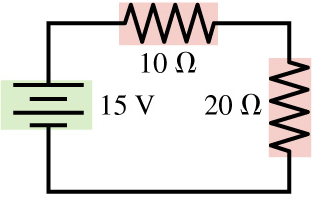Question
In: Physics
What is the potential difference across the 10 ω resistor?
figure

What is the potential difference across the 10ω resistor in the figure?
What is the potential difference across the 20ω resistor in the figure?
Solutions
Expert Solution
Voltage = 15 V
Equivalent Rsistance = 10 + 20 = 30 ohm = R
V = I*R
current through circuit I = V/R
I = 15/30 = 0.5 A
the potential difference across the 10ohm resistor in the figure = I *R(10) = 0.5*10 = 5 V
the potential difference across the 20ohm resistor in the figure= I *R(20) = 0.5*20 = 10 V
Related Solutions
A resistor of unknown resistance and a 22 Ω resistor are connected across a 20 V...
A resistor of unknown resistance and a 22 Ω resistor are
connected across a 20 V emf in such a way that a 2.0 A current is
observed in the emf. What is the value of the unknown
resistance?
For the circuit shown in the figure, find the current through and the potential difference across each resistor.
For the circuit shown in the figure, find the current through and the potential difference across each resistor.
Part A Find the current through 3 Ω resistor.
Part B Find the potential difference across 3 Ω resistor.
For the circuit shown in the figure (Figure 1 ), find the current through and the potential difference across each resistor.
For the circuit shown in the figure (Figure 1 ), find the current through and the potential difference across each resistor.For the steps and strategies involved in solving a similar problem, you may view a Video Tutor Solution.Part AFind the current through 3Ω resistor.Part BFind the potential difference across 3Ω resistor.
An ac voltage, whose peak value is 150 V, is across a 330 -Ω resistor.
An ac voltage, whose peak value is 150 V, is across a 330 -Ω resistor.
What is the peak current in the resistor? answer in A
What is the rms current in the resistor? answer in A
A resistor of R = 10 Ω is connected in series with an inductor of L...
A
resistor of R = 10 Ω is connected in series with an inductor of L =
2 H and a direct voltage source of 50 V forming an RL circuit.
Determine the current at time t, assuming that current does not
initially flow through the circuit. What is the maximum current
flowing through the circuit? In what time is half the maximum
current reached?
A 56.0-Ω resistor is connected in parallel with a 121.0-Ω resistor. This parallel group is connected...
A 56.0-Ω resistor is connected in parallel with a 121.0-Ω
resistor. This parallel group is connected in series with a 22.0-Ω
resistor. The total combination is connected across a 15.0-V
battery.
(a) Find the current in the 121.0-Ω resistor. A
(b) Find the power dissipated in the 121.0-Ω resistor. W
The voltage across each resistor in the two-resistor circuit is ___________ the voltage across the resistor in the one-resistor circuit.
The current through each resistor in the two-resistor circuit is _________ the current through the resistor in the one-resistor circuit (the circuit in Part A). The voltage across each resistor in the two-resistor circuit is ___________ the voltage across the resistor in the one-resistor circuit.
the same as / half
half / half
twice / half
half / twice
half / the same as
twice / twice
An unknown resistor R is connected to a 18.0 Ω resistor, and the combination is attached...
An unknown resistor R is connected to a 18.0 Ω
resistor, and the combination is attached to an ideal battery. When
the two resistors are combined in parallel, they consume 7.40 times
as much power as when they are combined in series. Determine the
two possible values for R.
1. Enter the smaller possible value of R.
2. Enter the larger possible value of R.
Suppose an electrical circuit contains a 1 H inductor, a 10 Ω resistor and a capacitor...
Suppose an electrical circuit contains a 1 H inductor, a 10 Ω
resistor and a capacitor rated at 1/7 F. If the circuit is hooked
up to an alternating voltage source described by E(t) = 68 cost V
and initially q(0) = 1 C and i(0) = 0 A, find a function that
describes the charge as a function of time. Lq'' + Rq' +
q/C = E(t).
Please show work using a complementary and particular solution
if possible.
A 200 Ω resistor is in series with a 8.50×10−2 H inductor and a 0.540 μF...
A 200 Ω resistor is in series with a 8.50×10−2 H
inductor and a 0.540 μF capacitor.
part A: Compute the impedance of the circuit at a frequency of
f1 = 500 Hz and at a frequency of f2 = 1000 Hz .
Enter your answer as two numbers separated with a comma.
part b: In each case, compute the phase angle of the source
voltage with respect to the current.
Enter your answer as two numbers separated with a...
ADVERTISEMENT
ADVERTISEMENT
Latest Questions
- In the drawing, the rope and the pulleys are massless, and there is no friction. The...
- Hyrdrofluoric acid (Ka = 7.2 x 10-4), is used in a wide range of commercial processes....
- Define polymer. Nucleotides are polymerized to form _______ and ________ while amino acids are polymerized to form...
- Write a C program to take two integer arrays in ascending order and combine them in...
- 1.Read the Lab6-Background.pdf first.2.Start the “Stack Queue” applet.3.The purpose of this exercise is to see how...
- A spaceship leaves the earth, starting from rest and accelerating at a constance rate of 10m/s^2....
- Calculate the effective interest rate for the following nominal interest rates: a. Interest rate of 11%...
ADVERTISEMENT
 Dr. OWL answered 5 years ago
Dr. OWL answered 5 years ago